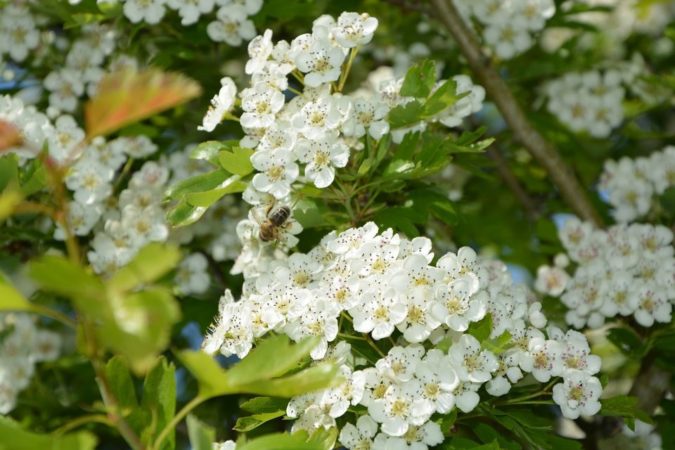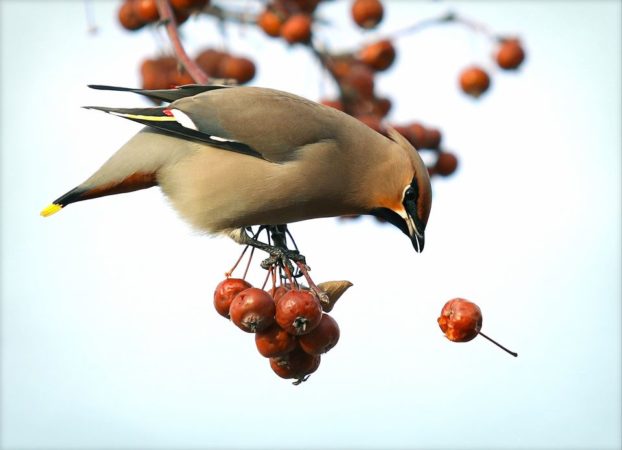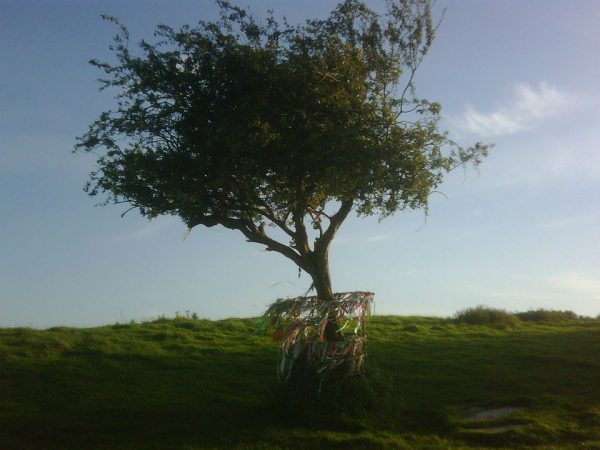In our new series we take a closer look at the tree species we see around us every day, dig up their colourful past and look for secrets beneath their leaves. First out is the Hawthorn aka Crataegus Monogyna.
Ever noticed the hedgerows snaking through the countryside and lining our fields? Maybe when they’re erupting with delightful little white flowers in spring? Chances are you’re looking at hawthorn. One of our native trees, they often take the form of hedges or shrubs but can be found as a single trunked tree between 5-12 metres tall. Most of the time it’s inconspicuous, but its ordinary demeanour hides a magical and colourful past which continues to influence our present.
How to identify it:
The hawthorn (Crataegus Monogyna) has small lobed leaves and thorns (see pictures). Very young stems are reddish in colour, the bark is brown with occasional orange cracks, sometimes green algae are found along the bark. The leaves appear before the flowers in spring, which are small, scented, usually white and appear in abundance. The fruits emerge in autumn, they are red berries known as haws and are a very valuable source of winter food for birds like thrushes and waxwings.

Also known as the May tree because it flowers in May, back in the day flowering branches were used as decorations outside houses. Why outside you may ask? Bringing them indoors was considered unlucky and associated with illness and death. Modern science has found that the chemical trimethylamine present in hawthorn blossom is also one of the first chemicals formed in decaying animal tissue, so it’s no wonder that they have this association. Still this didn’t stop people from eating the leaves and calling them bread and cheese.
The young leaves, flower buds and young flowers are all edible. The berries are also edible once processed and were mostly used to make jellies, wines and ketchups. But watch out, eaten raw the berries can cause a tummy upset.

On a more practical note hawthorn wood has a close grain and this makes it useful for carving, for making tool handles and other small household items.
One reason we see it all over the countryside is that during the time of the land enclosures, which started in the 12th century but really took off in the 18th and 19th centuries, folk started using it regularly as a field boundary hedge. Its sharp thorns and ability to grow thickly made it a perfect fence to ward off animal and human intruders.
The Hawthorn’s magical past:
Hawthorn has long been associated with faeries and witches. Celtic myths abound of the tricky faery luring human mortals into a world where time moved differently. And the hawthorn was one of the trees most likely to be inhabited or protected by the faery folk. These lone trees were often not cut down or damaged to prevent the wrath of their guardians. In one story Thomas the Rhymer, a famous Scottish poet and mystic from the thirteenth century met the Faery Queen by a hawthorn bush and was lead off to the faery underworld for a short time. On his return he found that 7 years had passed in the human world. Going further back to pre-Christian times, it’s possible that goddess worship was carried out in sacred hawthorn groves.
It turns out that the nick name “thorn” for hawthorn is the most common tree found in English place names, and the tree most frequently mentioned in Anglo-Saxon boundary charters. The site of Westminster Abbey was once called Thorney Island after the sacred stand of thorn trees there. Hawthorn is a tree that’s not only important to wildlife but has been significant to the people of these isles and woven into our lives for a very long time.
The super star of the Hawthorn family, however, is the Holy thorn of Glastonbury, and it was even featured on Christmas stamps in 1986.
In the 1530’s three of the Hawthorn trees near Glastonbury were found to flower twice, once in spring and then miraculously in winter too. Because of this people considered them Holy thorns. At some point the Glastonbury thorn became associated with legends about Joseph of Arimathea and the arrival of Christianity in Britain. According to legend, Joseph planted his staff in the ground and it took root to form the Glastonbury thorn.
Another tradition started in the early 17th century and still alive to this day is that of sending a flowering sprig of the Glastonbury thorn to the British Monarch every Christmas.
The Glastonbury thorn has been such a strong symbol in people’s minds that it has inspired devotion and destruction in equal measure over the centuries.

Glastonbury was an important early centre for Christianity, but nowadays it has become more of a draw for pagans and both groups have venerated the thorn. And both groups have those who may be antagonistic to it too. There are pagans who may be disgruntled with its use as a Christian symbol and Christians disgruntled with its use as a pagan symbol.
The original tree has been propagated several times, with one tree growing at Glastonbury Abbey and another in the churchyard of the Church of St John. The “original” Glastonbury thorn was cut down and burned as a relic of superstition during the English Civil War, and one planted on Wearyall Hill in 1951 to replace it had its branches cut off in 2010. Even in modern times people feel strongly enough about it to vandalise and destroy the replacement trees. Who took the trouble of chain sawing the tree branches off? It is still a mystery. What is clear is the emotive attention directed at the tree.
So, in fact the Glastonbury thorn is not one tree but several. It has been hard to preserve as the haws don’t lead to thorns that flower twice, cuttings have to be used to preserve that trait. Creating a clone with identical DNA. With the dedicated help of many people over the years the amazing and unique Glastonbury thorn continues to survive despite attempts to destroy it. An ancient symbol stoking high emotion in people even today. It highlights the mythic power of our trees to spark human imagination and drive two of the most basic and opposite of human instincts, that of creation and destruction.
What a useful, mysterious and otherworldly tree. It’s time to meet the real, ancient hawthorn again, the one that not only provides for all the creatures around it, but also casts its spell on our flowing imaginations. Our bond is deeper than we think. When you’re next near a hawthorn remember what it is, let it work its magic and keep your eyes peeled for a faery.
Source: https://www.treesforcities.org/
